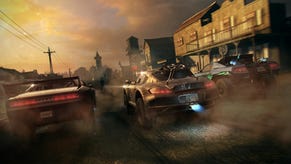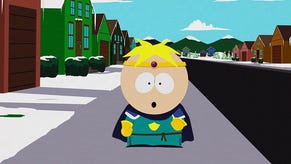Far Cry 4 Reveal Controversy: Marketing, Mature Themes, and the Trouble with Sequels
Can you judge a single image? Mike takes a look at the controversy that surrounded the reveal of Ubisoft's Far Cry 4.
This article first appeared on USgamer, a partner publication of VG247. Some content, such as this article, has been migrated to VG247 for posterity after USgamer's closure - but it has not been edited or further vetted by the VG247 team.
Last week, Ubisoft revealed Far Cry 4, the follow-up to the publisher's surprise hit, Far Cry 3. Well, revealed is a bit strong; the company merely announced the title, release date, and box art for the game, with a bit of DLC to entice pre-orders. The official site includes a call to action for potential Far Cry 4 fans: watch the E3 world gameplay premiere right on the site. It was a rather straightforward PR release.
The box art set off a minor internet firestorm.

The art that accompanied the press release (shown above) looks different from the Limited Edition box art that graces the official website currently. It depicted an unknown man in a pink suit with bleach blonde hair sitting on a defaced statue of that looks to be Buddhist origin. The man has his right hand on the head of another kneeling man who is holding a grenade. The official site names the background scenery as belonging to Kyrat, a fictional area of the Himalayan mountain range that separates India from China's Tibetan Plateau. (Action game fans will probably recall that as the same region that Uncharted 2: Among Thieves played out in.) It seems to be a callback to the cover of Far Cry 3, which featured the sociopathic Vaas.
We later got the full synopsis for the game via Ubisoft's Uplay:
"Hidden in the majestic Himalayas lies Kyrat, a country steeped in tradition and violence. You are Ajay Ghale. Traveling to Kyrat to fulfill your mother's dying wish, you find yourself caught up in a civil war to overthrow the oppressive regime of dictator Pagan Min. Explore and navigate this vast open world, where danger and unpredictability lurk around every corner. Here, every decision counts, and every second is a story. Welcome to Kyrat."
Perception and Franchise History
Some called the image racist; the gentleman in the pink suit looked Caucasian and is subjugating the kneeling, darker-skinned figure. Some were worried about homophobia via a homosexual villain; they fear the gentleman in the pink suit might be gay and he looks to be the antagonist of the piece. I'd need a bit more context before making those calls, but I can see why others did. I see strong hints of classic colonialism: culture A heads into a region occupied by other cultures, tears them down, and supplants the local lifestyle with their own. That's something that has previously been associated with racism, as colonialist expansion by European societies tended to tout their superiority over natives, as if they were doing them a favor. The leap isn't a huge one.
Many were worried about some of the themes Far Cry 4's cover potentially points to, mostly because Far Cry 3 tried to handle themes related to race and its execution wasn't up to snuff. Far Cry 3 was a difficult game for me. I absolutely loved the game part, but the story jabbed at me incessantly. Writer Jeffrey Yohalem intended for the game's story to be a satire of the white colonial trope - known as the noble savage in literature and most recently the white savior in film - but satire is a very hard thing to convey. Do it wrong and you end up reinforcing the ideas you're intending to satire.

Yohalem and the Far Cry 3 team tried to tell a certain story and failed. That's not a strike against their entire body of work. Yohalem himself was a writer on Assassin's Creed II, the lead writer on Assassin's Creed: Brotherhood, and one of the creators of Child of Light. One or two missteps in a career isn't bad at all. Unfortunately, that misstep does affect how we perceive the next game in a series, even though Ubisoft's huge studio system means an entirely different team is probably working on the title. It's a strike against the Far Cry franchise.
That's the double-edged sword aspect of a franchise; the name assures you certain number of repeat consumers, but it also means you carry the best and worse expectations forward. Assassin's Creed IV: Black Flag went up against fan's dissatisfaction with Assassin's Creed III and Unity will benefit from IV's rave reviews. Reception to the next Battlefield will be directly informed by the problems with Battlefield 4. Hyrule Warriors hopes to trade on the love of both Zelda and Dynasty Warriors franchises. In the same way, our response to any Far Cry 4 information is bolstered or tainted by our relationship with Far Cry 3. Far Cry 3's attempt at satire on a mature topic didn't work and that's a strike against the series as a whole, so Far Cry 4 must carry that burden forward.
Finding Maturity
A recent article on IGN talked about the backlash, chiding those who had a problem with the box art for not wanting to see adult themes in games. Of wanting everything to be vanilla, sanitized and safe for consumption. That misses the point entirely.
Those who have issues with the art don't have a problem with creators working with serious themes. The problem is doing it poorly. The problem is if you want to step up and be the True Detective, the Wire, the Sopranos, or the Mad Men of games, you need to do it well. You need to get in those wounds, really find out why they hurt, and actually do something meaningful with them. Violence, murder, drug use, abuse, torture, sex, rape, even the complex search for identity; all that is open to creators, but creators need to treat them with respect. They need to not just throw it out there for shock value, to get a rise out of players. That's a waste.

When you do it right, you get games like Spec Ops: The Line, Gone Home, Planescape Torment, The Walking Dead, Silent Hill, and Papers Please. When you handle mature themes with any type of sophistication, you get stunning work that people will rave about because they've been stuck with the same thing over and over again. Polygon's Ben Kuchera recently praised Wolfenstein: The New Order for handling sex in healthy way, because how the industry generally deals with sex and adult relationships is pretty crass.
Creators can tackle serious, mature themes, but then it falls upon them to do it well. To handle them with care and deftness, to say something resonant and true. But frequently, these themes aren't handled at all, they're just trotted out as shorthand. The bad guy who rapes a captive. The mob boss who kills an underling for failing in a task. The barely-clothed femme fatale. The native sidekick who guides the outsider through his or her culture. These are just ways to get from point A to point B without truly thinking about "why" or without seeing how it fits within the game's overall tone. What does this scene mean? What is the subtext? How does it relate to the rest of the game? What am I saying to the viewer?
Making a Judgment Call
The other argument I've seen is that one cannot judge the game based on a bit of box art. The art does not not provide enough context to tell what the game's story or gameplay will be like at all. This is 100 percent true.
We can however judge the art on its own merits. It's professionally produced. It was crafted in a specific way for a specific purpose: to market the game on websites, online storefronts, and retail shelves. To entice you to pre-order and purchase Far Cry 4. It wants to create positive feelings and associations within potential buyers. Did Ubisoft intend to anger people with the release of some box art? Probably not, but intent doesn't really factor in. You can intend to do one thing, and accomplish another. Just ask McDonalds, who learned this the hard way with its new, terrifying Happy Meal mascot.

Here's a simple truth: anything that can affect you in a positive manner can also do so in a negative one.
A specific trailer or poster can just as easily turn you away from a product. You can decide the box art doesn't sit right with you. A teaser trailer can look uninteresting to you. That demo level just didn't click with you. The showfloor presentation was a poor demonstration. Even the first few hours of a game can ultimately fail to pull you in. These glimpses may not perfectly represent the final product, in the same way a product may not live up to its marketing. They're all still personal judgments and estimates. Consumers make them every day because our time and money is finite. A game that bores you in the beginning may give way to something amazing, but most would rather just purchase and play something that's amazing all the way through.
The fact that these glimpses and teases may not accurately portray the finished game isn't your fault. That's on the content creators. Each release, each new bit of information, has its own context in addition to fitting into the larger whole. Everything matters. Every poster, developer quote, stage demo, and press event. That's why there are PR reps. (Incidentally, that's why PR dislikes leaks. An errant, uncontrolled video or screenshot could taint your feelings on a title.) Every screenshot, level, button press, and menu list is important. That's why talented developers exist. These works of marketing are absolutely meant to be judged and valued, the creators and product owners just hope you judge them in a positive manner. That's not always the case.
"Don't judge a book by its cover!" some say. That's great advice. Some art, a screenshot, or a trailer may turn you off a game, but that doesn't mean it's not worth it to keep an open mind. To swing back around and see if perhaps there's more to the final product. But it's perfectly valid and understandable to simply say, "I'm getting off this hype train, and here's why," in a civil manner.

Far Cry 4 may go on to outdo Far Cry 3 in every way possible. It may handle its mature themes in a superior way, with a story that backs up some amazing gameplay. I hope it does, because I enjoyed FC3 with caveats and I'd like to love FC4 without them.
Ubisoft's opening salvo on the road to Far Cry 4's November 18 release wasn't a completely successful one. It hyped up some, while turning off others. A bit more information was needed, like the leaked synopsis. Something to provide more context and understanding. Perhaps the E3 reveal will answer all questions and convert some players; it will change minds and reverse judgments. If not, we'll wait until the next reveal or tease after that, viewing each within their own context and the larger context of the final game. That's the hype machine working as intended, and we all participate in some way.








